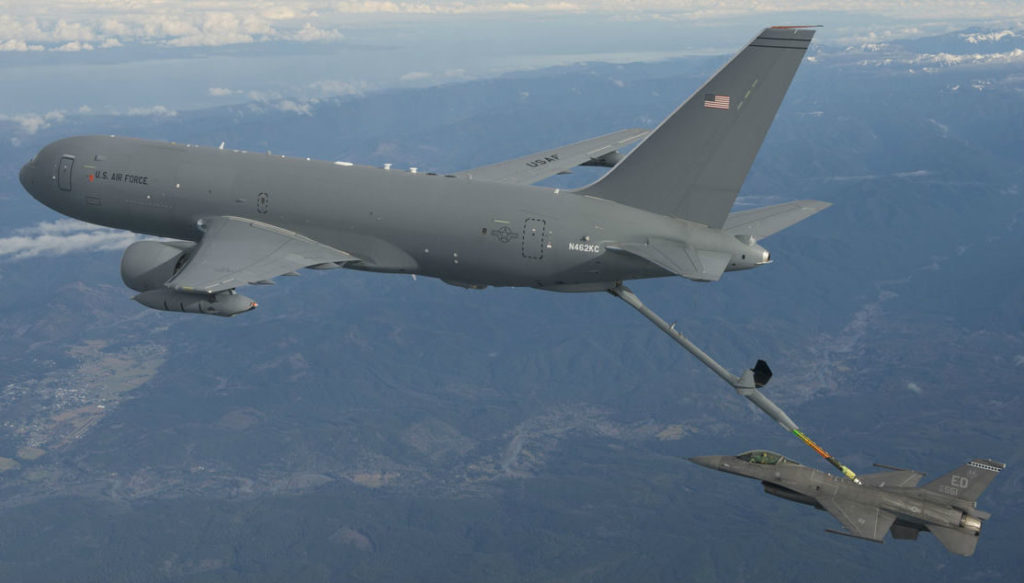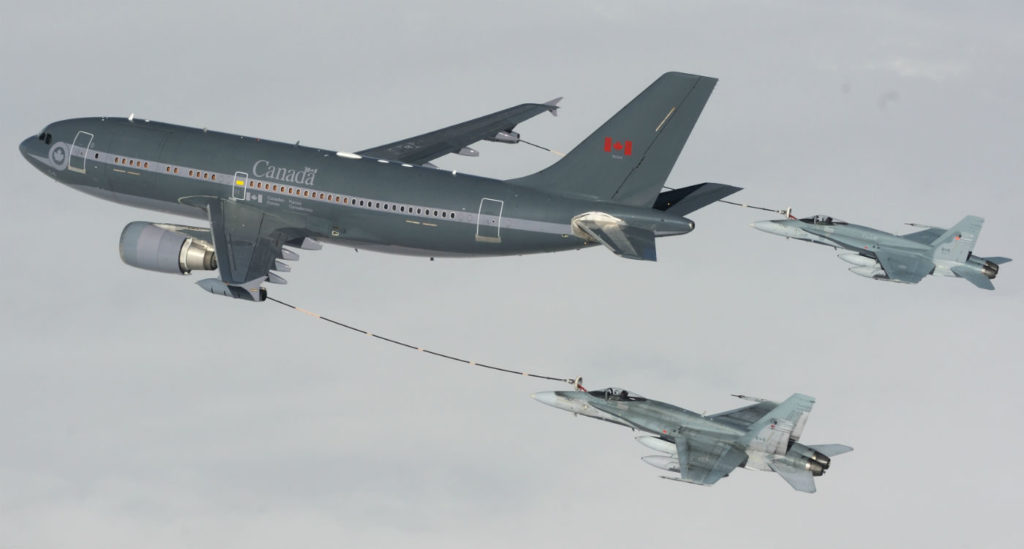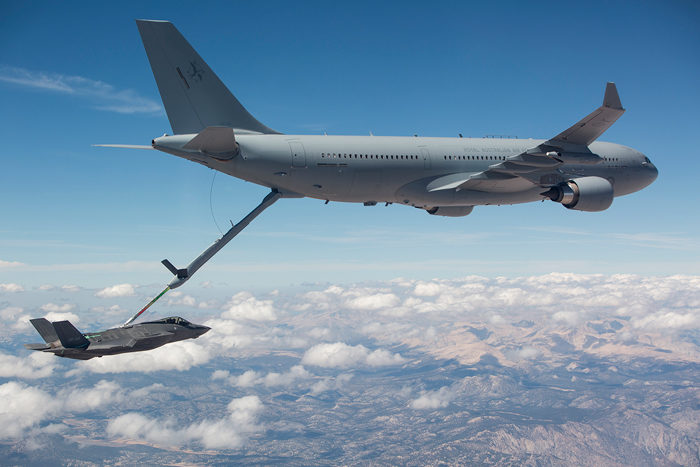Estimated reading time 10 minutes, seconds.
The Royal Canadian Air Force (RCAF) might prefer to wait for the federal government to reach a decision on the replacement of its fighter jet fleet before proceeding with a project to replace its air-to-air refuelling aircraft, but two of the likely contenders for the strategic tanker transport capability were positioning their aircraft for the role at the CANSEC tradeshow in Ottawa last week.

The RCAF operates a fleet of five Airbus A310-300s acquired in 1992 from Canadian Airlines. Known as the CC-150 Polaris, two were converted to tankers in 2008 to support the CF-188 Hornet fighter jets. All five have been operating at a high tempo in recent years and are expected to reach the end of their service life by about 2026, around the same time the Air Force hopes to take delivery of the eventual replacement for the Hornet fleet.
The tanker project is currently in the initial identification phase and a request for proposals is expected around 2021, followed by a contract award in 2022. RCAF commander LGen Mike Hood told parliamentarians last year that “[o]nce a decision is made on the next fighter aircraft, the next decision will be the tanker replacement.”
More recently, however, an RCAF spokesperson acknowledged the Air Force might need to act sooner. The weapon system manager responsible for maintenance of the A310 fleet commissioned a study to assess the estimated life expectancy. The results will determine whether the life of the fleet can be extended until after the next-generation fighter is selected or, “if the RCAF needs to proceed directly to the strategic tanker transport capability project to replace the CC-150 fleet.”
The findings were expected this spring but might be “pushed out to the end of summer,” retired Col Glenn Hanbey, Boeing Military Aircraft’s head of global sales for the KC-46 tanker program, told Skies. “What I hear is that they will probably extend the life of the Polaris and at the same time start looking at their analysis of alternatives for the future replacement for that aircraft.”
The U.S. Air Force (USAF) in February 2011 selected the KC-46 Pegasus, a derivative of the Boeing 767 commercial airliner, to replace the KC-135 Stratotanker, and is on track to take delivery of the first of 179 later this year. Six aircraft are currently conducting test flights, which are about 60 per cent complete, and another 20 are under construction. The USAF has about 400 of the KC-135s in inventory, many of which are close to 60 years of age.

Roberto Valla, vice-president of global sales for Canada for Boeing Defense, Space & Security, told Skies earlier this year that the Chicago-based company would bid the KC-46 as a replacement for the CC-150.
“The KC-46 is purpose built to be a tanker, it’s not just a commercial aircraft,” said Hanbey, a former USAF pilot with decades of experience on the KC-135, in an interview at CANSEC. He noted the addition of electromagnetic pulse hardening, crew cabin armour, gas inerting systems in the fuel tanks, and counter measures to radar warning receiver threats. “One of the requirements was that it be survivable in a medium threat environment.”
The aircraft can carry 212,299 pounds (96,265 kilograms) of fuel and be quickly configured for cargo (up to 18 pallets), 114 passengers, or aero medical.
Hanbey said the KC-46 had been assessed against the RCAF’s Arctic missions such as supporting the Hornets in countering Russian bomber incursions. Between the size of the aircraft, its ability to operate from short runways of 8,000 feet (2,438 metres), and a “good” thrust to weight ratio from two Pratt & Whitney 4062 engines, with 62,000 pounds of thrust each, the aircraft is “very efficient to do those types of missions.”
Airbus Defence and Space, meanwhile, was promoting its A330 multirole tanker transport (MRTT), a variant of the A330-200 airframe, with an astounding 111 tonnes of fuel capacity and a payload of up to 45 tonnes, which can be configured for up 300 passengers, 130 stretchers, or 37 tonnes of cargo.
“This makes it a unique product because no one else is able to provide this capacity, this capability all in one,” said Pablo Molina, the company’s head of military aircraft in Canada.

With the A330, Airbus has also increased the range over the Polaris. The CC-150 could escort four CF-188s from 3 Wing Bagotville, Que., to close to London without payload. The MRTT can deliver the same fighters, with 15 tonnes of payload in a combination of passengers and cargo, to east of Paris.
With eight customers and an order book of 51 aircraft, Molina said Airbus has, “been able to gather 85 per cent of the global market, if we exclude the U.S. market. Moreover, we ensure interoperability with allies using this platform.”
Airbus is also progressing with an evolution of the aircraft it calls Smart MRTT, which would capitalize on advances in big data to increase a range of command and control and signals intelligence capabilities.
In early May, Airbus also completed the first automatic air-to-air refuelling contact with a fighter jet. The demonstration highlighted a capability that could be available on the A300 MRTT by 2019 that reduces boom operator workload, enhances crew and fighter pilot safety, and improves the rate of mid-air refueling in combat conditions.
One of the arguments for delaying a decision on the CC-150 replacement until after the next fighter is identified has been the refuelling system itself. However, both the KC-46 and A330 MRTT are configured for boom and probe and drogue refuelling, and could adapt to whatever fighter Canada selects while still being interoperable with allies.
Molina noted the MRTT is able to supply fuel through fuselage pods and a boom, “one based on the U.S. Air Force, the other based on the U.S. Navy. With this aircraft, we will ensure Canada is able to accomplish both the NORAD [North American Aerospace Defense] and NATO [North Atlantic Treaty Organization] requirement.”
“One of the things the KC-135 did not have was the ability to probe and drogue or boom refuel on the same mission,” said Hanbey. “On the KC-46, you have a couple of options. It has the boom on the back, primarily for USAF fighters. But we also have a centreline drogue system. I know as a tanker planner during wartime ops, it was good to be able to have either one. We also have wing air refuelling pods that you can put on the KC-46 [to] do simultaneous probe and drogue refuelling off the wing tips.”









They sent you and old rendering. The KC-46A doesn’t have winglets…
Hi Mike,
Thank you for bringing this to our attention. The photo has now been updated.